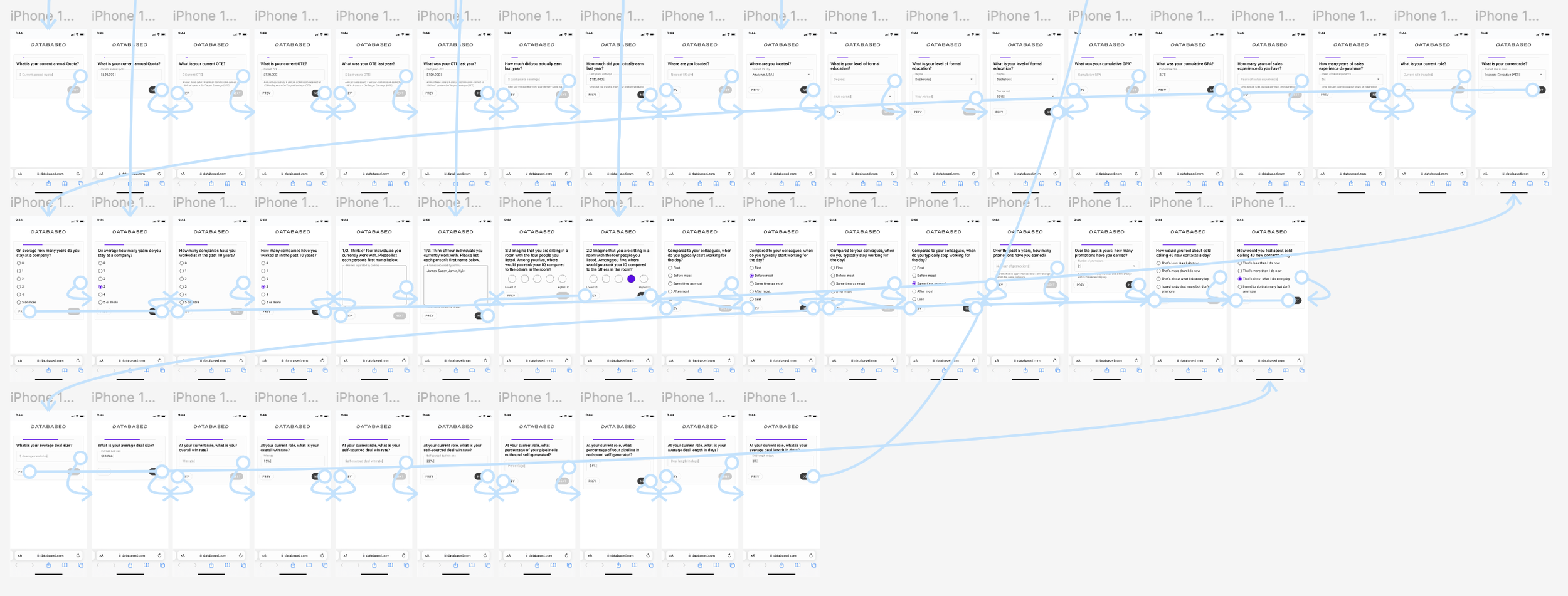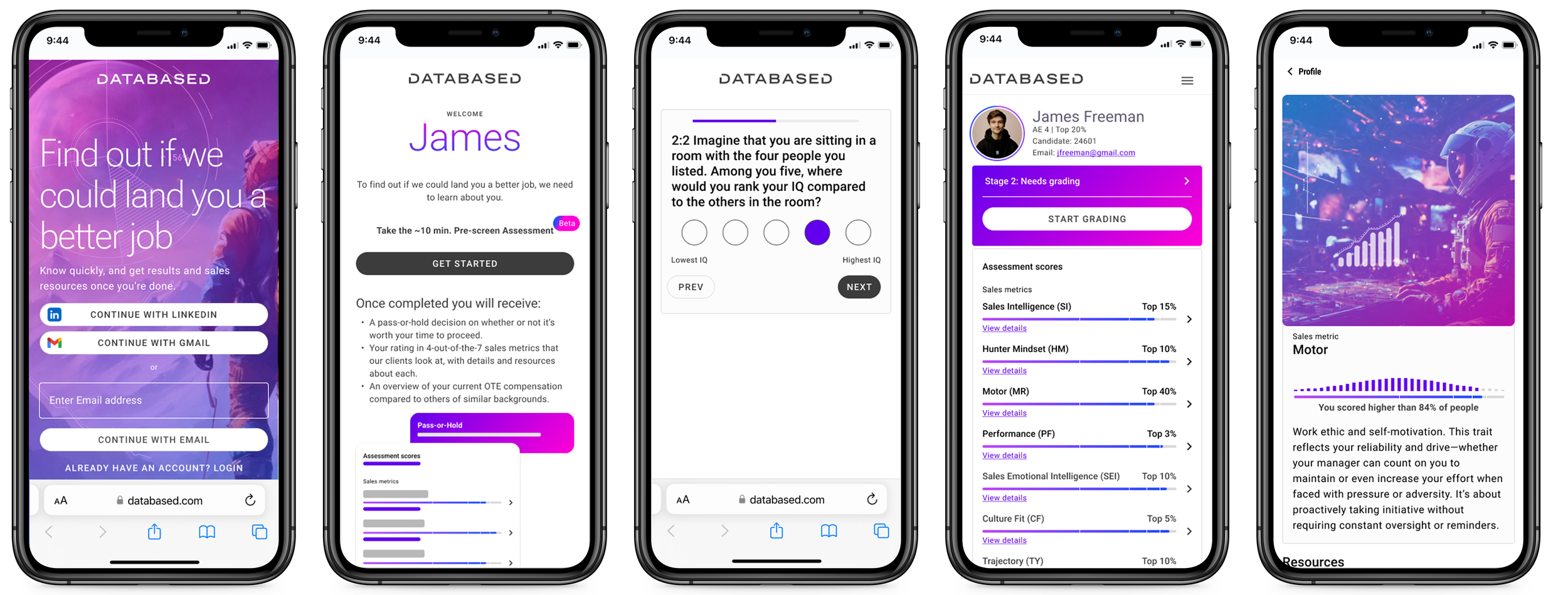DataBased | Recruiting
Overview
Role: Founding UX/Product Designer, Strategy, Research, User Interviews, Visual Design
Team: Founders, UX, Engineering
Outcomes: 4x faster than industry avg. | 10% better performance than peers | 2Q longer tenure | Startup Profitability
The Product:
DataBased Recruiting is a Sales and Go-to-Market specific recruiting partner that utilizes A.I. and Psychographic analysis surveys to streamline hiring and the scaling of sales and GTM teams.
The Problems:
For Users:
Cost of a bad hire is $1M+
Lengthy Hiring process = missed revenue targets
Bad hires lead to high attrition
For DataBased:
Our process was extremely manual and labor intensive
Lacked the ability to scale
The Goal
Develop a Sales and GTM recruiting service that could scale and perform better than the industry average and help great sales talent find great companies.
My Process
01. Research & Discovery
Working with our internal recruiters and our CEO/Co-founder I learned and documented our very effective and very manual recruiting process.
A key element was the psychographic survey and scoring process that enabled us to identify top talent based on character traits that others would overlook.
02. Problem Definition
While we could identify great sales talent, It took too long to grade their responses and pass along good candidates which cost us candidates and clients.
The candidates had to have a good experience while still providing us with the data we needed in order to be confident in those we passed along to clients, but it all had to be much faster
03. Ideation & Iteration
As my research with our existing candidate pool was ongoing, I used sketching and quick iterations to test out concepts and ways to make the process faster and more rewarding for them (and us).
“Could we train A.I. to grade the surveys as well as our team could and do it in seconds instead of days?
* For a more detailed look at the iterations and to see how the project took shape in Figma, see the *Design Iteration Process section at the end of the case study.
04. Solution alignment
I Aligned with engineering and the recruitment team to establish phases and roadmap so we could implement the new experience without interrupting their workflow.
Make an enjoyable experience so user completion would be high. Have responses graded by our own trained A.I. in seconds, the structure of the survey would have to change, but the results would be radically faster!
05. Prototype & Testing towards an MVP
As soon as I had elements of the journey ready, I worked with the dev team to place them into the recruiting team’s workflow so we could learn from real time feedback.
Feedback discovered and implemented during testing and iteration
“How can we make it less disappointing when people don’t pass?”
“The recruitment team will also need an admin tool to manage all the candidates and communication”
From SSO integration with Google & LinkedIn to the personalized welcome screen, the survey questions, results, and insights on next steps.
06. Development & Launch
Each phase was launched as soon as it was determined to be faster than the current human process.
07. Impact
Increased usage of data-backed commitments lead to an increase in our customers’ rep performance metrics and quota attainment.
⏱4x
DataBased fills roles 4x faster than the industry average
💸10%
DataBased candidates achieve 10% higher quota attainment than their peers
🗓 2Q
DataBased candidates stay and average of 2 quarters longer than their peers
*Design Iteration Process 👇
IYKYK. Every step has questions to answer and it’s not linear
An Idea
Q: Can we help early-stage companies find top sales talent faster than anyone else?
It started with a 2 day Pie-in-the-Sky concept to guide internal alignment and excitement around creating a candidate/recruiting product.
Ideas to pursue:
Profile for Candidates
Filtering and finding for companies
Candidate Insights into areas for growth
Community around Sales?
Heuristic Audit
Q: Why is our current process not working?
An afternoon of talking with our internal team, several of our recent candidates about their experience, and mapping the current product.
Problems:
Took users 45m-1hr to complete
Took our Team 2-7 days to grade
Most was done personally over a phone or video call
Not scalable
Not rewarding for candidates
References
Q: What are other psychographic surveys that people actually enjoy interacing with?
Knowing that a big part of this would be the actual Survey and onboarding of candidates, I spent a day researching other surveys and assessments to get an idea of how it could be structured, screen capturing a few examples that I felt aligned with our vision.
Learnings:
People like learning about themselves
Usually have a goal in mind of what they want to get after the survey
Feels worth the effort to the user
User Journey
Q: What will this look like from first interaction all the way to our final goal of placing top talent at companies?
Mapped out our initial Journey we wanted candidates to have from initial contact all the way to being placed with a company.
Eventually we revisited this to develop our marketing strategy.
V1
Q: What could a simple profile creation process look like and would that be valuable enough to get candidates in our door?
Created a simple test from Landing page -> Onboarding -> to a profile page to test with former candidates.
Learnings:
Don’t forget, there will be a large survey needed from candidates
The final payoff seems underwhelming
Could this help the candidate learn anything about themselves?
V2
Q: What kind of info at the end will make going through the survey worthwhile?
Communicate that there will be an assessment survey. Give the user more info and resources when they are finished
Learnings:
Loved the idea of getting a breakdown of my strengths and weaknesses!
Could it be more straightforward as to whether or not I will get a job out of all this?
Could it be more gamified?
V3
Q: How can me make staying engaged with the product long enough to take the entire assessment more likely?
Add badges and achievements for an element of gamification to show growth and potential for employment.
Learnings:
Gamification was Interesting, not a huge game changer
They’re already motivated, they want to find a good job
Like the idea of DataBased helping me on this really stressful journey into the unknown
Still unsure of how candidates will react to the actual survey and profile creation
Work with Dev on Survey question types and grading AI LLM Training.
V4
Q: How can we build trust with candidates to increase their likelihood of finishing the survey?
Can we embrace the idea that we’re helping them on the journey into the unknown that they are already on?
Learnings:
Like the step-by-step building rather than a single page with multiple fields. Way less overwhelming.
Better reaction to visuals and more engaging, more users expressed interest from the very beginning!
What will this give me and what are the expectations up front?
SSO experience is ready for Dev so we can start getting candidate profiles into our recruiters’ hands.
V5
Q: Can we get them from onboarding to full profile in the first interaction?
Lean into the “Space Journey” concept.
Make profile creation and survey seamless.
Does the candidate understand what they are getting into?
What happens after the survey?
Learnings:
Made it from sign-up to full profile page smoothly! “Next steps” make sense, just need it a bit more clear
Liked the simple survey experience! (even though it was much longer as one whole survey)
End-to-End feels logical and natural Majority test subjects went through without hesitation!
Need to clean up and smooth out interstitial screens for more complete experience.
Dev can start building out Survey experience and Summary page!
V6
Q: Can people go end to end without any hand holding or prompts?
Map of complete experience: Onboarding -> Survey/Profile building -> Summary of results -> Scheduled Next Event -> Metric explanations/course resources -> Next Steps for passed & Failed -> Our internal tool
Learnings:
Made it from sign-up to full profile page into “Next steps” with hiring team smoothly!
Internal team excited with being able to search/filter results easily and have all the info they need to do next steps!
Dev Handoff of onboarding, and next step pages!
QA Review and update Survey and Summary experience with Dev Team, mock up any changes for Dev reference.
Updates on live product
Q: What more do we need to make this effective for the recruiting team:
After being able to use the entire experience in the real world, A few additional tools would be helpful for our team to manage the influx of candidates at scale:
Export anonymous results to share with clients
Ability to edit and add notes to a candidate that we are working with
Throughout the project, Figma’s comment tool was the team’s preferred method of documenting updates or receiving clarification.








